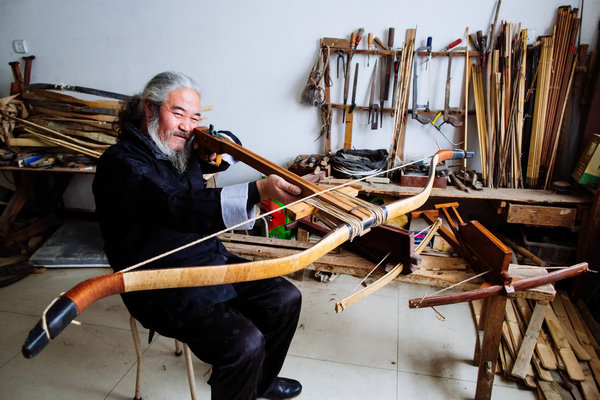 |
|
To enliven the stories behind his choice of objects, Lindesay seeks what he refers to as 'living continuities' or present keys to the past. He interviewed Yang Fuxi, a 10th-generation bowmaker and crossbow-maker, to tell the story of the crossbow's trigger.[Photo by James Lindesay/ China Daily] |
The feeling got stronger when he saw and heard of things that covered important episodes of the Wall's story in London, Oxford, Washington, the Vatican and Berlin.
"In 2012, I decided it was time to unite all these objects into one storyline, the story of the Great Wall told through 50 objects," he says.
The book is divided into five parts: Survey, Foundations, Intrusions, Core and Ruins. The heading of each part "is a construction term but is also that part of the Great Wall story that I'm looking at", he says.
In the Survey part, Lindesay introduces eight objects that help readers to get into the story. Then, from Foundations onwards, the objects are arranged in chronological order.
In the section Intrusions, he features a camel figurine carrying a group of foreign musicians to represent the trade of the Silk Road.
This is the middle period of the 2,300-year history of the Wall between the collapse of the Han Dynasty (206 BC-AD 220) and the rise of the Ming Dynasty (1368-1644) when the most-famous section, Badaling, was built.
"I learned a lot, such as why the Tang Dynasty (AD 618-907) didn't build a wall, because they use tax revenues from the trade to support other methods, like pacification policies and military offensives," he says.
One of the most interesting parts of the book is the reference to the Mongolian horse.
Lindesay includes it in book as a living animal rather than an object from antiquity.
"The curator of the National Museum of Mongolia asked me whether I planned to include the Mongolian horse in the book. I'd never thought of it because it was an animal, not an article from antiquity. But when he explained that 'nomads could never have reached China without the horse', it made me realize what a great story that would be," he says.
The book will be published in Britain and the US next year.
|
|
|
|
|
|
|
|
